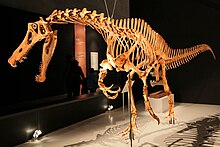Vallibonavenatrix
| Vallibonavenatrix | |
|---|---|

| |
| Life restoration based on the animal's fossil remains and those of close relatives | |
| Scientific classification | |
| Domain: | Eukaryota |
| Kingdom: | Animalia |
| Phylum: | Chordata |
| Clade: | Dinosauria |
| Clade: | Saurischia |
| Clade: | Theropoda |
| Family: | †Spinosauridae |
| Genus: | †Vallibonavenatrix Malafaia et al., 2019 |
| Type species | |
| †Vallibonavenatrix cani Malafaia et al., 2019
| |
Vallibonavenatrix (meaning "Vallibona huntress" after the town near where its remains were found) is a genus of spinosaurid dinosaur from the Early Cretaceous (Barremian) Arcillas de Morella Formation of Castellón, Spain. The type and only species is Vallibonavenatrix cani, known from a partial skeleton.[1]
Discovery and naming
[edit]During the late 1980s and early 1990s, amateur fossil collector Juan Cano Forner was recovering bones from various localities in Els Ports Natural Park, located in the Province of Castellón, Spain. In one of these—the Santa Águeda locality in the town of Vallibona—he excavated numerous vertebrate remains dating to the Mesozoic era, among which were dinosaur fossils. Forner housed these fossils in a private collection at Sant Mateu, which the Generalitat Valenciana acknowledged as a museographic collection in 1994. In 2007, the Spanish palaeontologist Fernando Gómez-Fernández and colleagues published a provisional description on the pelvis of a theropod from Forner's collection. Further fossils from the same specimen included a cervical (neck) vertebra, six dorsal (back) vertebrae, an almost complete sacrum, fragments of neurapophyses, four caudal (tail) vertebrae, ten partial ribs and rib fragments, three incomplete chevrons, an almost complete left ilium (main hip bone), fragments of the ventral part of a right ilium, incomplete right and left ischia (lower and rearmost hip bone), and a fragment interpreted as belonging to the proximal part of a pubis (pubic bone).[1]
In 2019, Elisabete Malafaia and colleagues published their description of a new genus and species of spinosaurid dinosaur, Vallibonavenatrix cani, with the partial skeleton as the holotype specimen. The generic name refers to the town of Vallibona, with the Latin suffix "-venatrix", meaning "huntress". The specific name honours Cano Forner, the fossil's discoverer. Vallibonavenatrix represents the most complete spinosaurid specimen recovered from the Iberian Peninsula.[1] Other Iberian spinosaurids include Iberospinus, Camarillasaurus, Protathlitis, and Riojavenatrix.[2]
Description
[edit]
Vallibonavenatrix was a moderately-sized bipedal predator. The upwards-projecting neural spines of its dorsal vertebrae were moderately tall, and one known spine is expanded from bottom to top in a trapezoidal, fan-like shape, similar to those of the spinosaurid Ichthyovenator. Similarities between the morphology of the neural spines of these two taxa may indicate the presence of elongated spines forming a sail on Vallibonavenatrix's back, as is seen in some other spinosaurids. The sacrum of Vallibonavenatrix had deep pleurocoelous fossae (depressions) and pneumatic (air-filled) openings. The ilium of the pelvis was also highly pneumatic, and had large internal chambers.[1]
Classification
[edit]
In 2019, Malafaia and her team classified Vallibonavenatrix within the Spinosauridae, a family of large-bodied tetanuran dinosaurs traditionally separated into two subfamilies: Spinosaurinae and Baryonychinae. Though closer in proximity to European baryonychines such as Baryonyx from the Barremian of Spain and England, Vallibonavenatrix was found to be more closely related to spinosaurines such as Spinosaurus and Irritator from the southern supercontinent Gondwana, and the Asian genus Ichthyovenator. Thus, Malafaia and colleagues placed it within Spinosaurinae. The results of their analysis are shown in the following cladogram:[1]
| Spinosauridae |
| |||||||||||||||||||||
However, in 2021, Chris Barker and colleagues instead found Vallibonavenatrix in one of two positions, depending on the type of analysis (parsimony-based or Bayesian) that they performed: outside of both Spinosaurinae and Baryonychinae as the most basal (least specialized) spinosaurid, or as a member of the Baryonychinae. They concluded that its phylogenetic position was unstable.[3]
Like the results of Barker et al., a 2022 study by Octávio Mateus and Darío Estraviz-López did not find Vallibonavenatrix to be a spinosaurine. However, certain anatomical characteristics may indicate an affinity with that group, rather than with the baryonychines.[4]
Palaeoenvironment
[edit]Vallibonavenatrix hails from the Arcillas de Morella Formation, which has been dated to the Barremian stage of the Early Cretaceous period, between 129.4 and 125 million years ago.[1] It coexisted in this environment with other dinosaurs including the ornithischians Iguanodon bernissartensis and Morelladon beltrani, an indeterminate sauropod, and fellow spinosaurid Protathlitis.[5][6]
References
[edit]- ^ a b c d e f Malafaia, E.; Miguel Gasulla, J.; Escaso, F.; Narváez, I.; Luis Sanz, J.; Ortega, F. (2019). "A new spinosaurid theropod (Dinosauria: Megalosauroidea) from the late Barremian of Vallibona, Spain: Implications for spinosaurid diversity in the Early Cretaceous of the Iberian Peninsula". Cretaceous Research. 106: 104221. doi:10.1016/j.cretres.2019.104221. S2CID 202189246.
- ^ Isasmendi, E.; Cuesta, E.; Díaz-Martínez, I.; Company, J.; Sáez-Benito, P.; Viera, L. I.; Torices, A.; Pereda-Suberbiola, P. (2024). "Increasing the theropod record of Europe: a new basal spinosaurid from the Enciso Group of the Cameros Basin (La Rioja, Spain). Evolutionary implications and palaeobiodiversity". Zoological Journal of the Linnean Society. doi:10.1093/zoolinnean/zlad193.
{{cite journal}}:|last4=has generic name (help) - ^ Barker, C.T.; Hone, D.; Naish, D.; Cau, A.; Lockwood, J.; Foster, B.; Clarkin, C.; Schneider, P.; Gostling, N. (2021). "New spinosaurids from the Wessex Formation (Early Cretaceous, UK) and the European origins of Spinosauridae". Scientific Reports. 11 (1): 19340. Bibcode:2021NatSR..1119340B. doi:10.1038/s41598-021-97870-8. PMC 8481559. PMID 34588472.
- ^ Mateus, Octávio; Estraviz-López, Darío (2022-02-16). "A new theropod dinosaur from the early cretaceous (Barremian) of Cabo Espichel, Portugal: Implications for spinosaurid evolution". PLOS ONE. 17 (2): e0262614. Bibcode:2022PLoSO..1762614M. doi:10.1371/journal.pone.0262614. ISSN 1932-6203. PMC 8849621. PMID 35171930.
- ^ Weishampel, David B; et al. (2004). "Dinosaur distribution (Early Cretaceous, Europe)." In: Weishampel, David B.; Dodson, Peter; and Osmólska, Halszka (eds.): The Dinosauria, 2nd, Berkeley: University of California Press. Pp. 562. ISBN 0-520-24209-2.
- ^ Verdú, F.J.; Godefroit, P.; Royo-Torres, R.; Cobos, A.; Alcalá, L. (2017). "Individual variation in the postcranial skeleton of the Early Cretaceous Iguanodon bernissartensis (Dinosauria: Ornithopoda)". Cretaceous Research. 74: 65–86. doi:10.1016/j.cretres.2017.02.006.















